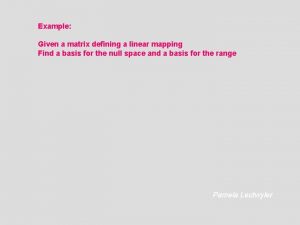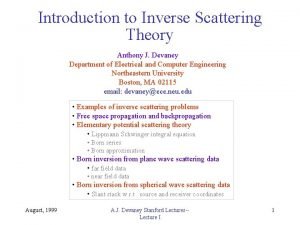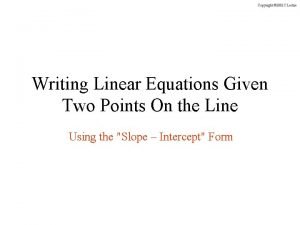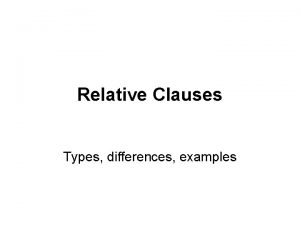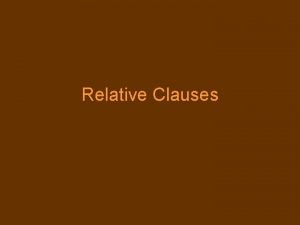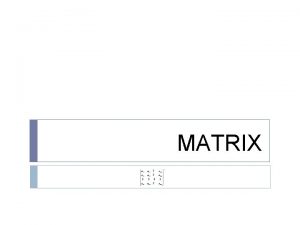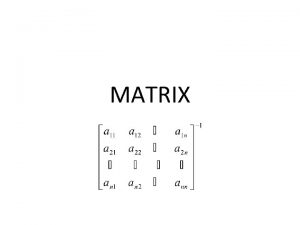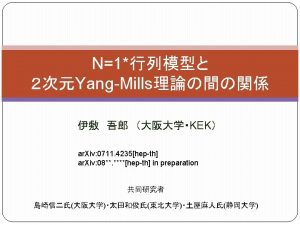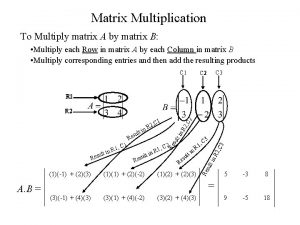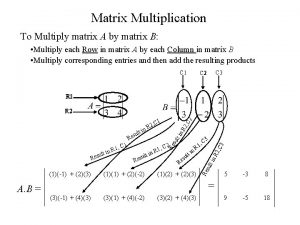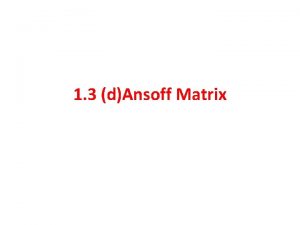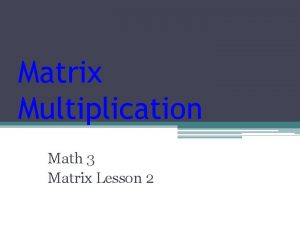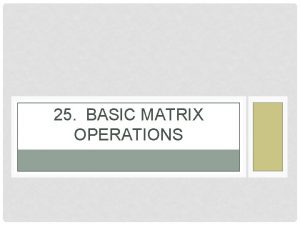Example Given a matrix defining a linear mapping


















- Slides: 18

Example: Given a matrix defining a linear mapping Find a basis for the null space and a basis for the range Pamela Leutwyler

Let M be the matrix for the linear mapping T ( ie: )

Let M be the matrix for the linear mapping T ( ie: ) Note: This vector is in the null space of T The vectors in the null space are the solutions to

Let M be the matrix for the linear mapping T ( ie: ) To find a basis for the null space of T you must solve:

Let M be the matrix for the linear mapping T ( ie: ) To find a basis for the null space of T you must solve:

Let M be the matrix for the linear mapping T ( ie: ) To find a basis for the null space of T you must solve:

Let M be the matrix for the linear mapping T ( ie: ) To find a basis for the null space of T you must solve: Every vector in the null space looks like:

Let M be the matrix for the linear mapping T ( ie: ) To find a basis for the null space of T you must solve: A basis for the null space = Every vector in the null space looks like:

Let M be the matrix for the linear mapping T ( ie: ) To find a basis for the range of T, remember that the columns of M span its range. Every vector in the range looks like:

Let M be the matrix for the linear mapping T ( ie: ) To find a basis for the range of T, remember that the columns of M span its range. Every vector in the range looks like: a linear combination of the columns of M

Let M be the matrix for the linear mapping T ( ie: ) To find a basis for the range of T, remember that the columns of M span its range. This is not a basis because the vectors are not independent

Let M be the matrix for the linear mapping T ( ie: ) To find a basis for the range of T, remember that the columns of M span its range. This is not a basis because the vectors are not independent + =

Let M be the matrix for the linear mapping T ( ie: ) To find a basis for the range of T, remember that the columns of M span its range. This is not a basis because the vectors are not independent =

Let M be the matrix for the linear mapping T ( ie: ) To find a basis for the range of T, remember that the columns of M span its range. Find the largest INDEPENDENT subset of the columns of M. These 2 vectors still span the range and they are independent.

Let M be the matrix for the linear mapping T ( ie: ) To find a basis for the range of T, remember that the columns of M span its range. Find the largest INDEPENDENT subset of the columns of M. { , } A basis for the range of T

Let M be the matrix for the linear mapping T ( ie: ) To find a basis for the range of T, remember that the columns of M span its range. Find the largest INDEPENDENT subset of the columns of M. Hint: wherever you see a FNZE in the reduced echelon form of the matrix, choose the original column of the matrix to include in your basis for the range. 1 1 the reduced echelon form of M (see slide 7 ) { , } A basis for the range of T

Let M be the matrix for the linear mapping T ( ie: ) A basis for the null space = the dimension of the null space = 2 A basis for the range = the dimension of the range = 2

Let M be the matrix for the linear mapping T ( ie: ) A basis for the null space = the dimension of the null space = 2 A basis for the range = the dimension of the null range = 2 The domain = R 4 the dimension of the domain = 4 The dimension of the null space + the dimension of the range =the dimension of the domain
 Defining/non-defining relative clauses
Defining/non-defining relative clauses Relative clauses defining and non defining
Relative clauses defining and non defining Defining and non-defining
Defining and non-defining Defining relative clause meaning in telugu
Defining relative clause meaning in telugu Defining vs non defining relative clauses
Defining vs non defining relative clauses Non essential adjective clause
Non essential adjective clause Matrix mapping example
Matrix mapping example Memory parameters
Memory parameters Forward mapping vs backward mapping
Forward mapping vs backward mapping Transform mapping dan transaction mapping
Transform mapping dan transaction mapping Intervention mapping approach example
Intervention mapping approach example Asimtor
Asimtor Non-linear mapping
Non-linear mapping Non-linear mapping
Non-linear mapping Non-linear mapping
Non-linear mapping Given the following mrp matrix for item d
Given the following mrp matrix for item d Writing equations given two points
Writing equations given two points Connective relative clauses
Connective relative clauses Defining sentence example
Defining sentence example






